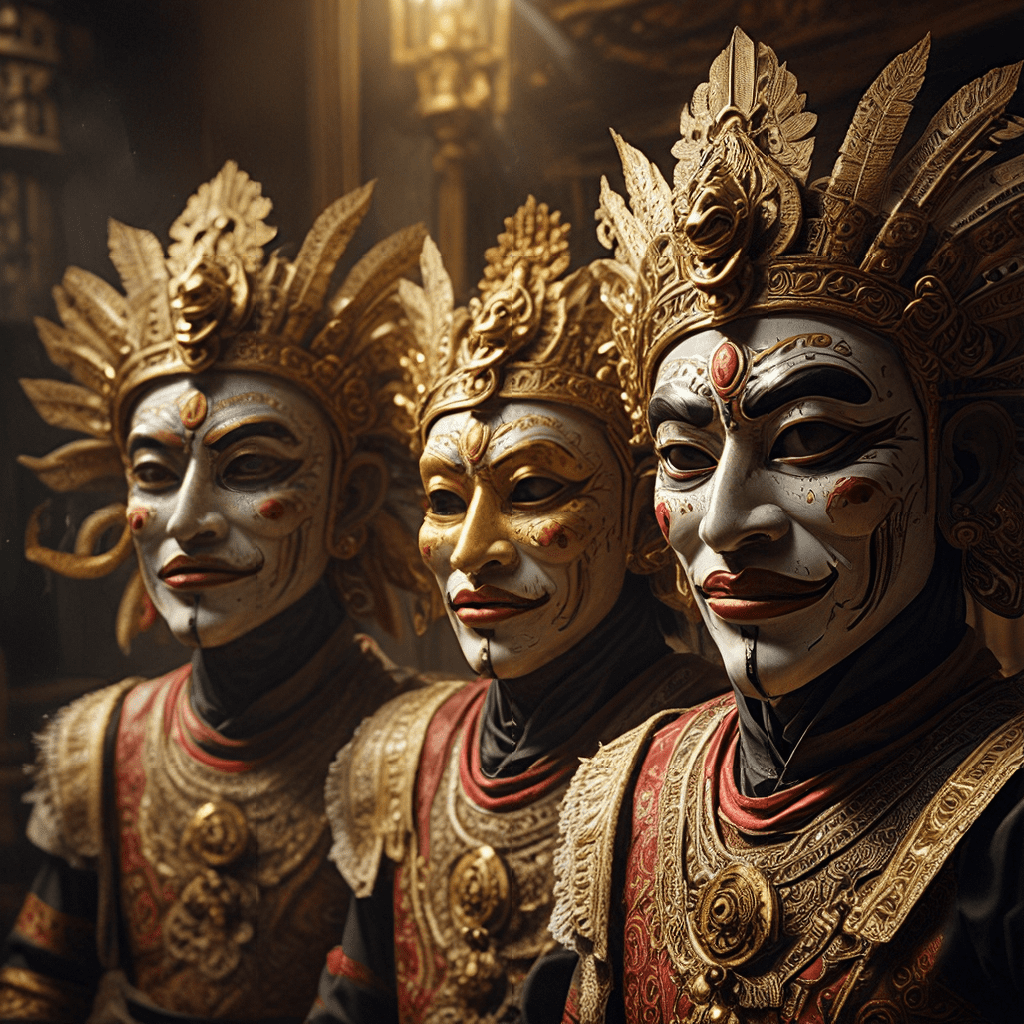A Tapestry of Myths: The Foundation of Indonesian Theater
Indonesian theater is a vibrant and ancient art form deeply intertwined with the country's rich mythology and cultural heritage. For centuries, stories of gods, demons, heroes, and mythical creatures have been woven into theatrical performances, captivating audiences and preserving Indonesia's rich folklore. These theatrical traditions showcase the influence of Hindu, Buddhist, and indigenous beliefs, creating a unique tapestry of myths and legends that continue to inspire artists and audiences today.
Indonesia's diverse islands, each with its own unique cultural traditions, have contributed to a vast array of theatrical styles and mask designs. From the theatrical dances of Bali to the puppet shows of Java, each region boasts distinct artistic expressions that reflect their local myths and legends.
This rich theatrical heritage has played a significant role in shaping Indonesian culture, serving as a platform for storytelling, education, and social commentary. By embodying the characters and stories of their mythology, performers have not only entertained audiences but also fostered a deeper understanding and appreciation of their cultural heritage.
The Ancient Origins: Tracing the Roots of Masks in Indonesian Culture
The use of masks in Indonesian theater dates back centuries, with evidence suggesting their use in ancient rituals and ceremonies. These masks, crafted from wood, leather, and other materials, were believed to possess spiritual power and were used to embody deities, spirits, and other supernatural beings.
In ancient Java, for example, masks were used in elaborate ceremonies honoring the gods and ancestors. These rituals often involved elaborate dance performances and the use of masks to transform performers into divine beings.
The use of masks in these early ritualistic performances evolved into theatrical traditions, where masks became a powerful tool for storytelling and embodying various characters. Over time, different regions developed their own unique mask styles and theatrical traditions, each reflecting the specific beliefs and cultural practices of their communities.
A Universe of Gods and Demons: Divinities and Creatures of Indonesian Myth
Masks in Indonesian theater are not merely decorative elements; they are representations of the diverse deities, mythical creatures, and spiritual beings that populate Indonesia's rich mythology. Each mask is carefully crafted to embody the unique characteristics and powers of the being it represents.
The pantheons of Hinduism and Buddhism have deeply influenced Indonesian mythology, introducing figures like Shiva, Vishnu, Brahma, and Buddha into its folklore. These deities are often depicted in theatrical performances, with masks designed to capture their divine essence and power.
But Indonesia's mythology extends beyond these borrowed deities, incorporating a vast array of indigenous spirits, mythical creatures, and supernatural beings. Masks representing these beings, such as the mythical bird Garuda, the water spirit of Nyi Roro Kidul, and the mischievous spirit of Wewe Gombel, are integral to many theatrical performances.
The Power of Transformation: Masks as Symbols of Spiritual and Physical Change
For performers, masks are more than simple props; they are powerful tools that facilitate transformation into different characters and beings. By putting on a mask, an actor can transcend their physical self and embody the spirit of the character they are portraying.
This process of transformation is a vital element of Indonesian theater, allowing performers to embody the essence of gods, demons, heroes, and other mythical figures. The masks become extensions of the performer's body and spirit, allowing them to fully inhabit the role they are playing.
In the hands of skilled performers, masks can evoke a profound sense of wonder and awe, transporting audiences into a world of myth and legend. The transformative power of masks has made them a vital part of Indonesian theater for centuries, allowing audiences to experience the magic and wonder of their cultural traditions firsthand.
The Language of Masks: Understanding the Symbolic Meanings and Expressions
Masks in Indonesian theater are not just decorative; they are a language in themselves, conveying a wealth of meaning and symbolism through their design and presentation. Each element of a mask—its shape, color, materials, and ornamentation—is carefully chosen to communicate specific ideas and emotions.
The shape of a mask can signify the character's nature. For example, a mask with a wide mouth might represent a character who is loud and boisterous, while a mask with narrow eyes might represent a character who is cunning and secretive.
The colors used on a mask also hold symbolic significance. Red, for instance, might represent passion and power, while white might represent purity and innocence.
The materials used to create a mask also carry cultural weight. A mask crafted from wood might represent strength and longevity, while a mask made of leather might represent flexibility and adaptability.
Through the careful integration of these symbolic elements, masks in Indonesian theater communicate a wealth of information to the audience, enriching their understanding of the characters and the stories they are witnessing.
The Role of Masks in Ritual and Ceremony: Honoring the Divine and The Ancestral
Masks in Indonesian theater are deeply rooted in ancient rituals and ceremonies, where they were used to connect with the spiritual realm and honor the divine and the ancestral. These performances often involved elaborate dances, chants, and offerings to appease deities, seek blessings, or commemorate ancestors. Masks were essential tools in these rituals, embodying the presence of the divine and allowing performers to communicate with the spiritual world.
In Bali, for instance, masks are used in various ceremonies, including temple festivals, offerings to the gods, and rituals for the dead. The Barong, a mythical lion-like creature, is a popular mask used in Balinese rituals and dances, representing both good and evil. The Barong's presence is believed to ward off evil spirits and protect the community from harm.
In Java, masks are used in Wayang Kulit (shadow puppet plays), a popular form of traditional theater. These performances often depict stories from the Hindu epics, Ramayana and Mahabharata, and involve elaborate puppetry and masked characters. The masks in Wayang Kulit are traditionally made of intricately carved leather and symbolize the various characters and their respective roles in the story.
These ritualistic performances, imbued with the power of masks, serve as a vital link between the spiritual and the earthly realms. They are a testament to the enduring beliefs and cultural traditions that have shaped Indonesian society for centuries.
The Spectacle of Storytelling: Masks in Popular Performances and Traditional Theater
Beyond their ritualistic significance, masks also play a crucial role in the storytelling tradition of Indonesian theater. Masks become an integral part of the narrative, visually representing characters and their personalities. The audience can quickly recognize and understand the character's essence through the mask's design and symbolic elements.
The Wayang Kulit shadow puppet shows in Java are a prime example of this storytelling tradition. The puppets, intricately carved and adorned with masks, become animated figures in the hands of the dalang (puppet master). The dalang uses the puppets and masks to enact stories from Indonesian mythology, epics, and folklore.
In Bali, the Legong dance, an elegant and intricate dance form, features dancers wearing ornate masks that embody the characters of the story. The masks, often depicting deities, princesses, or mythical creatures, enhance the visual spectacle of the dance, adding symbolic meaning and storytelling depth.
The use of masks in these performances adds a unique visual and symbolic dimension to Indonesian theater, captivating audiences and enhancing the storytelling experience.
The Mask as a Medium for Morality: Exploring Themes of Good and Evil, Virtue and Vice
Masks in Indonesian theater are not simply decorative elements; they are powerful tools for exploring universal themes of good and evil, virtue and vice. They represent the complexities of human nature and the constant struggle between opposing forces.
The Barong, a mythical lion-like creature in Balinese theater, embodies the forces of good. The Rangda, a witch-like figure, represents the forces of evil. The conflict between these two figures is a recurring theme in Balinese theater, symbolizing the ongoing struggle between good and evil.
In Wayang Kulit puppet shows, masks are used to depict various characters, including heroes, villains, gods, and demons, each representing a specific moral compass or personality.
These masks not only visually represent the characters but also act as a visual metaphor for the moral dilemmas faced by individuals and society. They allow the audience to contemplate the complexities of human nature and the choices that lead to virtuous or wicked paths.
Masks as a Window into the Soul: The Psychology of Mask-Wearing and its Impact on Performers
The act of wearing a mask has a profound psychological impact on the performer. By putting on a mask, the performer enters a transformative state, embodying the character's personality, emotions, and motivations. This process allows the performer to explore different facets of human experience, stepping outside their own identity and delving into the depths of the character they portray.
The mask can act as a barrier, allowing the performer to express emotions and behaviors they might not feel comfortable revealing in their own persona. It can also heighten the performer's senses, enhancing their awareness of the audience and the theatrical space.
The psychological impact of mask-wearing is a vital aspect of Indonesian theater, allowing performers to tap into their creative potential and deliver deeply compelling performances.
A Legacy of Masks: The Evolution and Continued Relevance of Masks in Contemporary Indonesian Theater
Despite the changing cultural landscape, masks remain an enduring symbol of Indonesian theater. While modern adaptations of traditional performances sometimes incorporate contemporary elements, masks continue to be widely used, reflecting their enduring power and cultural significance.
Contemporary artists in Indonesia are also exploring new ways to incorporate masks into their work, incorporating contemporary materials and artistic styles. They use masks to express personal narratives, social commentary, and explore contemporary themes, demonstrating the enduring versatility and relevance of this ancient art form.
The legacy of masks in Indonesian theater is a testament to the rich cultural heritage of the nation. These masks continue to inspire artists and captivate audiences, ensuring that the ancient art of storytelling through masks will continue to thrive for generations to come.
FAQ
Q: What are some common materials used to make masks in Indonesian theater?
A: Masks are often made from wood, leather, bamboo, and other materials, reflecting the unique resources and traditions of each region.
Q: How do masks help to tell stories in Indonesian theater?
**A: **Masks represent characters, their personalities, and their roles in the story. They visually communicate important information to the audience and enhance the narrative.
Q: What are some of the psychological effects of wearing a mask in Indonesian theater?
A: Masks allow performers to embody characters, explore different emotions, and create a sense of transformation.
Q: How are masks used in modern Indonesian theater?
A: Modern Indonesian artists incorporate masks into contemporary performances, exploring new designs and artistic expressions.



